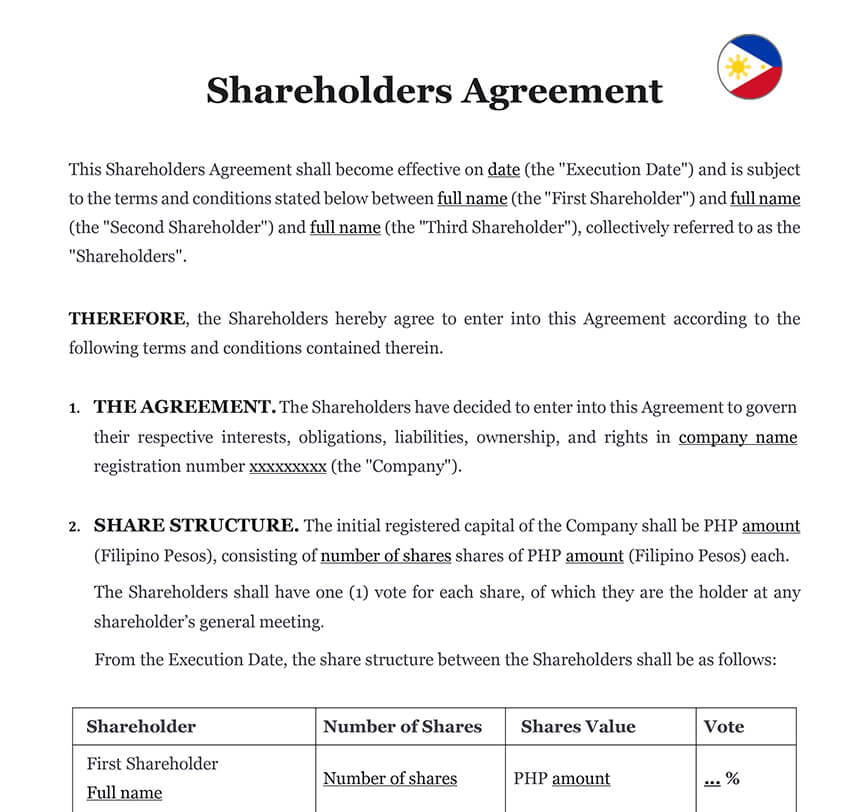Ready to use legal template
Drafted by experienced lawyers
Compliant with Filipino law
Ready to use legal template
Drafted by lawyers
Compliant with Filipino law
Home › Business contracts › Shareholders agreement
Learn more about Shareholders Agreement in Philippines
A Shareholders Agreement is a legal contract that outlines the rights, responsibilities, and obligations of shareholders in a company. It defines important aspects such as ownership structure, decision-making processes, voting rights, profit distribution, and dispute resolution. In the Philippines, a well-drafted Shareholders Agreement helps prevent conflicts, ensures business continuity, and protects the interests of all parties involved. Whether you’re setting up a new business or restructuring an existing one, a Shareholders Agreement safeguards your company’s future by establishing clear guidelines from the start. Download our professionally drafted Shareholders Agreement, fully editable in Word format and tailored for use in the Philippines to ensure your business runs smoothly with well defined shareholder rights and protections.
Table of contents
What is a Shareholders Agreement?
A company’s shareholders may opt to sign another legal document, the Shareholders’ Agreement, in addition to the articles of organization. This “extra-statutory” agreement establishes specific regulations governing the operation of the firm and shareholder relations. The articles of association and the Shareholders’ Agreement are therefore two distinct documents that should not be confused: the articles of association constitute the company’s foundation instrument, while the agreement completes and modifies its operation.
It is common to hear the words “Partnership Agreement” and “Shareholders’ Agreement” used interchangeably. The distinction between these two agreements is based on the legal structure of the organization in question. A shareholders’ agreement is used in joint stock businesses such as public limited companies or simplified joint stock companies. Domestic corporation, civil companies, and other partnerships, on the other hand, are referred to as partners’ agreements.
Why does a Shareholders’ Agreement cover?
Shareholders’ Agreements are frequently employed as a safety and to protect shareholders, because they may specify what happens if ‘things go wrong.’ The lack of this agreement greement increases the possibility of shareholder disputes and disagreements.
This agreements include clauses that anticipate issues and outline suitable ways to resolve them. Too frequently, people form businesses with friends and family and do not think about preserving their interests until it is too late.
The following are reasons why it is critical to invest time and money in obtaining a Shareholders’ Agreement :
1. Shareholders may disagree
It is impossible to see the company partners falling out or having problems making choices at the outset of a fresh business engagement. Disagreements do arise, unfortunately. It is simpler to formalize and codify the method that should be taken if the relationship goes sour from the start.
2. Control the company's management
The board of directors is normally in charge of the company’s operations. However, shareholders may argue that some decisions should not be left completely to the discretion of the directors and should instead be subject to shareholder approval. This is especially true if the directors are not stockholders. Borrowing or incurring capital expenditure in excess of a specific amount, for example.
3. Provides minority owners with protection
This Agreement can safeguard minority shareholders by, for example, prohibiting the issuance of additional shares without majority authorization, which would otherwise erode their stake. The agreement may also include “tag-along” clauses, which allow a minority shareholder to “tag on” to a majority shareholder in the event of a share sale.
4. Provides majority shareholder protection
This agreement may also safeguard majority shareholders. “Drag along” provisions are typically used when an offer to purchase all of the shares in a firm is received and the majority shareholders desire to accept the offer. The rights enable the majority to compel the other shareholders to accept the offer on the same conditions. Without it, the buyer may back out.
5. Limitations
If a shareholder wishes to leave the firm, the remaining shareholders frequently want for limits on current shareholders’ capacity to start or work in a competitive business. These limits can be harsher than those in any Employment Contract and can be extremely beneficial in preserving the company’s interests in the future.
6. Demonstrates financial stability
This document may indicate stability for your firm by demonstrating that you have planned ahead of time so that any issue can be resolved easily and quickly. This is very crucial for banks and other creditors who may be interested in investing in your firm.
What are the advantages of a Shareholders Agreement?
The formation of a Shareholders’ Agreement might rapidly show to be valuable and required in the context of the creation or life of a firm.
The agreement’s discretion is one of its primary benefits. Because it is not published in the Journal Officiel, it may contain provisions that one desires to keep private. Because this act is confidential, neither other parties nor non-signatory shareholders can learn what it says.
Second, because of its distinctiveness, the agreement provides for the resolution of certain issues unique to individual partners. It may also include stipulations designed to apply for a short time, which is not conceivable with the company’s articles of association, which are intended to control the company’s organization for the duration of the company’s existence. Another intriguing aspect is the considerable freedom it provides its members. Shareholders have a lot of discretion according to the notion of contractual freedom.
Why use this Shareholders’ Agreement?
In contrast, some of the most significant dangers of not having a shareholders’ agreement are:
| ➤ If things do not go as planned, complications may occur if stockholders do not have a clear exit strategy. |
| ➤ Shareholders who quit the company's employment may be allowed to keep their shares (which may include the opportunity to vote at meetings or receive a dividend), which is typically economically undesirable. |
| ➤ Minority shareholders are obliged to rely on statutory rights, which can be difficult and expensive to enforce in reality. |
| ➤ Minority shareholders may have the ability to prevent a transaction. |
| ➤ If there is a stalemate and no resolutions are reached at the director or shareholder levels, severe steps such as winding up the firm may be the only choice for the shareholders, which may be exceedingly time-consuming and costly. |
| ➤ By law, shares are freely transferable unless prohibited by the articles of organization of a corporation or any applicable agreement between shareholders. As a result, without suitable share transfer limitations, the shares may be transferred to unknown third parties. |
| ➤ By law, shares are freely transferable unless prohibited by the articles of organization of a corporation or any applicable agreement between shareholders. As a result, without suitable share transfer limitations, the shares may be transferred to unknown third parties. |




